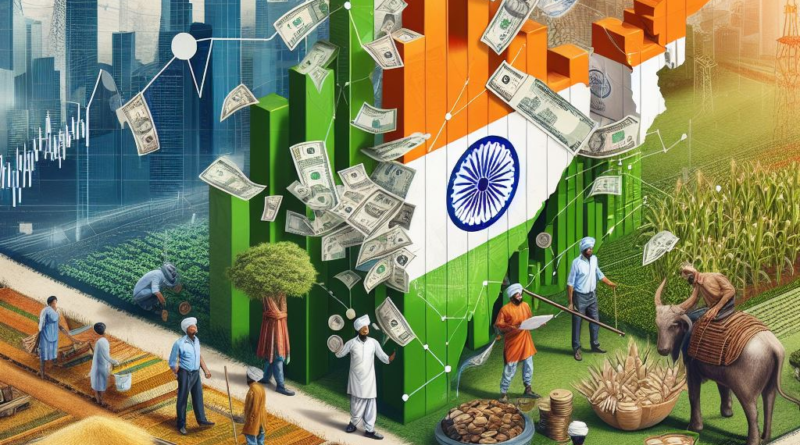India’s Economic Status and Roadmap to Development | Ias Banenge
Context:
Currently, India is classified as a “lower-middle income” country with a per capita GDP ranging between $1,136 and $4,465. In contrast, China stands as an “upper-middle income” nation with a per capita GDP between $4,466 and $13,845. Looking ahead, even with a modest annual GDP growth rate of 6%, India is projected to become the world’s third-largest economy by 2028. To achieve its vision of a “Viksit Bharat” or developed India by 2047, India should aim to significantly boost its per capita GDP to levels between $13,000 and $14,000. This focus on economic growth and development will be crucial in elevating India’s global stature and improving the standard of living for its citizens.
Relevance:
GS III: Indian Economy
READ MORE- Steel Ministry’s Initiative Towards Green Steel Policy and Decarbonization
Dimensions of the Article:
- China’s Growth Story
- Why India’s Focus Must be on Per Capita?
China’s Growth Story:
Historical Perspective:
- Starting from similar economic levels in 1990, China rapidly outpaced India in economic growth.
- In 1990, China’s economy was marginally larger than India’s by 1.2 times. However, by 2010 and 2022, this gap widened significantly to 3.6 times and 5.3 times respectively.
Growth Trajectory:
- China experienced sustained double-digit growth rates during the 1990s and 2000s, which propelled its per capita GDP beyond the $10,000 mark by 2019.
- Despite a slight moderation in growth to an average of 7% since 2010 and 5.3% in the five years leading up to 2022, China remains on a robust growth trajectory.
Future Projections:
- With an economic size of $18 trillion in 2022, China is poised to potentially overtake the US ($25.4 trillion GDP in 2022) as the world’s largest economy by the early to mid-2030s, based on current growth rates.
Where India Stands?
Economic Performance:
- India’s real GDP growth in dollar terms has decelerated, averaging 5.9% between 2010-22 and further dropping to 5.7% over the nine years from 2014.
- Despite its nominal GDP reaching $3.4 trillion in 2022, which is close to China’s 2007 levels, India has lagged in economic growth compared to its eastern neighbor.
Global Ranking:
- While India has improved its global GDP ranking from No. 10 to No. 5 between 2013 and 2022, this ascent has been driven by a relatively modest average annual growth rate of 5.7%.
- For context, Japan and Germany, with nominal GDPs of $4.3 trillion and $4.1 trillion respectively in 2022, surpass India’s economic output.
Future Potential:
- To attain the position of the world’s No. 3 economy by 2028, India would need to sustain a growth rate of 6% in current dollars. In comparison, for Japan and Germany to maintain their positions, they would only need a growth rate of 2%.
Why India’s Focus Must be on Per Capita?
Geopolitical Weight vs. Economic Well-being:
- While aggregate GDP is crucial for determining a country’s geopolitical influence on the global stage, it may not necessarily reflect the economic well-being of its citizens.
- For instance, Monaco, Liechtenstein, and Bermuda may have the highest per capita GDPs globally, but their small populations and unique economic structures do not equate to superpower status.
Relevance of Per Capita GDP for India:
- Given India’s vast population and its current developmental stage, per capita GDP is equally significant as aggregate GDP.
- It serves as an indicator of the average economic prosperity and living standards of the population.
Components of GDP Growth:
- GDP growth is influenced by two primary factors: population growth and growth in per capita output.
- Population growth is demographic in nature, whereas growth in per capita output reflects improvements in the overall standard of living.
Chinese Growth Story – A Case in Point:
- China’s economic growth has been exceptional, witnessing a nearly 46-fold expansion in its economy from 1990 to 2022.
- More importantly, this growth has been accompanied by a significant rise in its per capita GDP, which surged from $348 (slightly lower than India’s $369) to an impressive $12,720 (significantly higher than India’s $2,411) during the same period.
Path to Development – A Target for India:
- To be classified as a “high-income” country by the World Bank, a nation must achieve a per capita GNI (gross national income) threshold of $13,846.
- For India to realize its vision of becoming a “Viksit Bharat” or a developed nation by 2047, it is imperative to strive towards reaching this per capita income benchmark.
-Source: Indian Express





Pingback: Agricultural Transformation in West Bengal | Ias Banenge